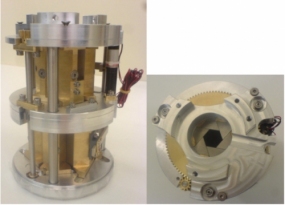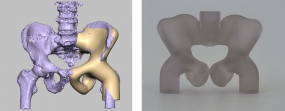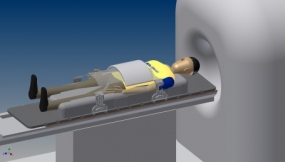E0405 Medical Engineering
Group leader: Armin Runz
The medical engineering workgroup is mainly a service group for the department of medical physics.
In cooperation with our workshop and external companies ideas become 3d-CAD-constructions, drawings and in the end prototypes of medical devices, especially in the sectors stereotactical equipment, collimators, patient immobilization aids and anthropomorphic elastic phantoms. Furthermore medical devices - developed at the DKFZ - have to be tested and quality assured. Therefore we design and build testing sets and phantoms which allow routinely controlling.
As high quality standards for radiation therapy at DKFZ demand controlling of the machines beyond standard requirements individual phantoms have to be built, designed and developed in the workgroup.

Figure: Prototyp of a double-stage iris collimator
© dkfz.de
Many developments such as manually and motor driven multi-leaf-collimators have been licensed and are in use in different clinics. A special design of a double-stage iris collimator which has been patented was licensed and is used in radiation therapy in combination with a special linac since 2008.

From CT-data to anthropomorphic 3D-hollow model
© dkfz.de
To create various phantom models different manufacturing processes are used, such as milling, drilling, casting and 3d-printing.
Based on CT or 3d-scanner data anthropomorphic models are generated. After modification via software these models are printed with a 3d-printer.
With the aid of 3d-printed casting molds elastic phantoms made of silicone can be fabricated. These phantoms can be used for research and gel-dosimetry.

© dkfz.de

© dkfz.de
In cooperation with the department of radiotherapy a MRI-Linac-Shuttle system was developed, including positioning aids and a stereotactic localization system.
ARTEMIS Project
Radiotherapy is one of the most prescribed tumor treatments, using high doses of ionizing irradiation to achieve tumor control and preserve healthy tissue from damage. As there may be significant differences between patient's morphology at the treatment day compared to the day of the planning we designed a new principle to acquire daily MR images for any final treatment position to enable irradiation without a gantry. Therefore, within the ARTEMIS Project (funded by the Federal Ministry of Education and Research (FMER), grant no. 13GW0436B) a patient fixation and rotation system was developed and tested for CT and MR scanners, as well as on the treatment table of a light ion beam treatment facility.
This patient immobilization and rotation system was developed and tested to enable MR and CT imaging directly before irradiation to adapt the treatment plan according to the daily tumor and OAR position and shape. Additionally, this setup enables radiation treatment from different angles even at a fixed horizontal beam-line, as the capsule can be rotated axially on the treatment table. Thereby, the need for an expensive gantry for irradiation might becomes obsolete. This may allow for much cheaper installation of treatment facilities with high quality image guidance.
After receiving the CE labelling, we will finally test the system with patients in the near future also in a CT environment. In the long term, the system may also be used for a low-cost MR-Linac solution.
Publication:
Echner G, Dinkel F, Beyer C, Jäkel O. PO-1913 Development and test of a patient immobilization and rotation device for imaging and radiotherapy. Radiotherapy and Oncology. 2023;182:S1663-S4. DOI: 10.1016/S0167-8140(23)66828-8

